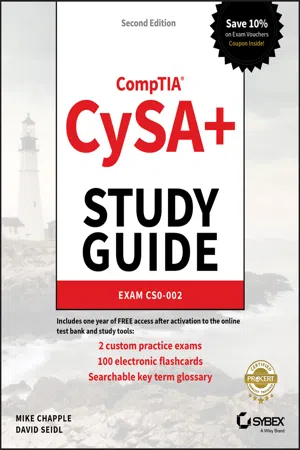
- English
- ePUB (mobile friendly)
- Available on iOS & Android
CompTIA CySA+ Study Guide
About this book
This updated study guide by two security experts will help you prepare for the CompTIA CySA+ certification exam. Position yourself for success with coverage of crucial security topics!
Where can you find 100% coverage of the revised CompTIA Cybersecurity Analyst+ (CySA+) exam objectives? It's all in the CompTIA CySA+ Study Guide Exam CS0-002, Second Edition! This guide provides clear and concise information on crucial security topics. You'll be able to gain insight from practical, real-world examples, plus chapter reviews and exam highlights. Turn to this comprehensive resource to gain authoritative coverage of a range of security subject areas.
- Review threat and vulnerability management topics
- Expand your knowledge of software and systems security
- Gain greater understanding of security operations and monitoring
- Study incident response information
- Get guidance on compliance and assessment
The CompTIA CySA+ Study Guide, Second Edition connects you to useful study tools that help you prepare for the exam. Gain confidence by using its interactive online test bank with hundreds of bonus practice questions, electronic flashcards, and a searchable glossary of key cybersecurity terms. You also get access to hands-on labs and have the opportunity to create a cybersecurity toolkit.
Leading security experts, Mike Chapple and David Seidl, wrote this valuable guide to help you prepare to be CompTIA Security+ certified. If you're an IT professional who has earned your CompTIA Security+ certification, success on the CySA+ (Cybersecurity Analyst) exam stands as an impressive addition to your professional credentials. Preparing and taking the CS0-002exam can also help you plan for advanced certifications, such as the CompTIA Advanced Security Practitioner (CASP+).
Frequently asked questions
- Essential is ideal for learners and professionals who enjoy exploring a wide range of subjects. Access the Essential Library with 800,000+ trusted titles and best-sellers across business, personal growth, and the humanities. Includes unlimited reading time and Standard Read Aloud voice.
- Complete: Perfect for advanced learners and researchers needing full, unrestricted access. Unlock 1.4M+ books across hundreds of subjects, including academic and specialized titles. The Complete Plan also includes advanced features like Premium Read Aloud and Research Assistant.
Please note we cannot support devices running on iOS 13 and Android 7 or earlier. Learn more about using the app.
Information
Chapter 1
Today's Cybersecurity Analyst
- Domain 3.0: Security Operations and Monitoring
- 3.4 Compare and contrast automation concepts and technologies.
- Machine Learning
- 3.4 Compare and contrast automation concepts and technologies.
- Domain 5.0: Compliance and Assessment
- 5.1 Understand the importance of data privacy and protection.
- Privacy vs. Security
- 5.1 Understand the importance of data privacy and protection.
Cybersecurity Objectives

Privacy vs. Security

Exam Note
- Management says that the organization should document its privacy practices in a privacy policy and related documents.
- Notice says that the organization should notify individuals about its privacy practices and inform individuals of the type of information that it collects and how that information is used.
- Choice and consent says that the organization should obtain the direct consent of individuals for the storage, use, and sharing of PII.
- Collection says that the organization should collect PII only for the purposes identified in the notice and consented to by the individual.
- Use, retention, and disposal says that the organization should only use information for identified purposes and may not use information collected for one stated purpose for any other nondisclosed purpose.
- Access says that the organizatio...
Table of contents
- Cover
- Table of Contents
- Acknowledgments
- About the Authors
- About the Technical Editor
- Introduction
- Chapter 1: Today's Cybersecurity Analyst
- Chapter 2: Using Threat Intelligence
- Chapter 3: Reconnaissance and Intelligence Gathering
- Chapter 4: Designing a Vulnerability Management Program
- Chapter 5: Analyzing Vulnerability Scans
- Chapter 6: Cloud Security
- Chapter 7: Infrastructure Security and Controls
- Chapter 8: Identity and Access Management Security
- Chapter 9: Software and Hardware Development Security
- Chapter 10: Security Operations and Monitoring
- Chapter 11: Building an Incident Response Program
- Chapter 12: Analyzing Indicators of Compromise
- Chapter 13: Performing Forensic Analysis and Techniques
- Chapter 14: Containment, Eradication, and Recovery
- Chapter 15: Risk Management
- Chapter 16: Policy and Compliance
- Appendix A: Practice Exam
- Appendix B: Answers to Review Questions and Practice Exam
- Appendix C: Answers to Lab Exercises
- Index
- End User License Agreement